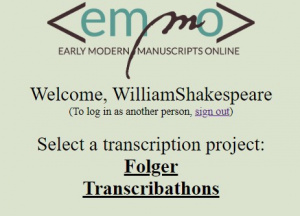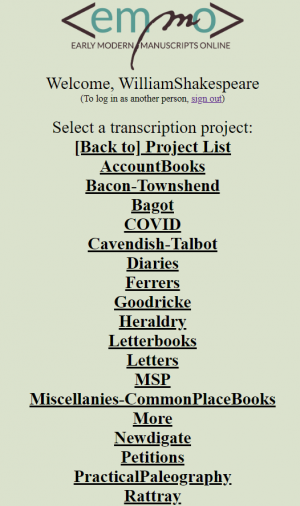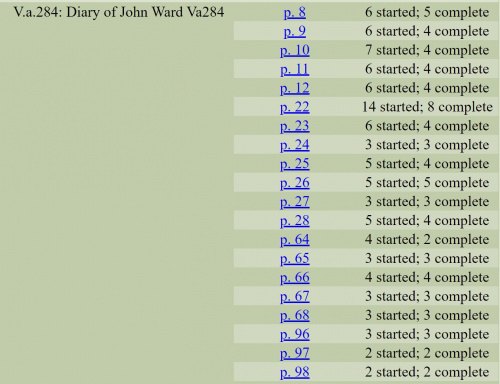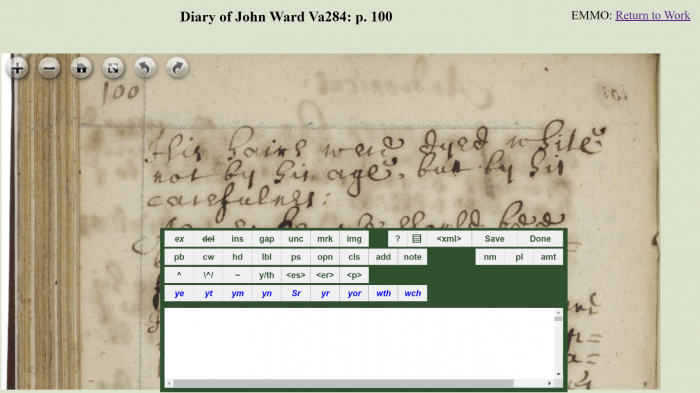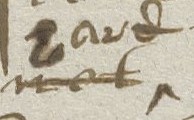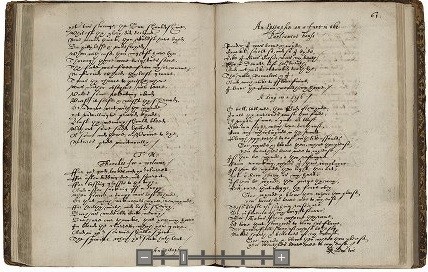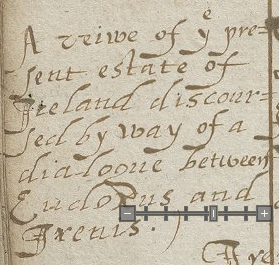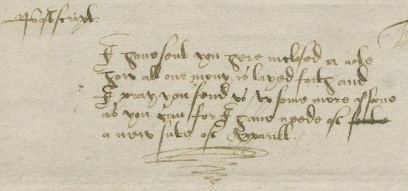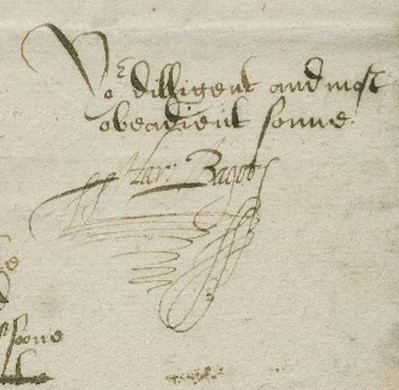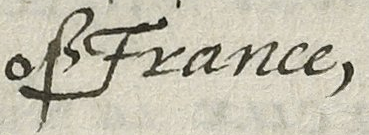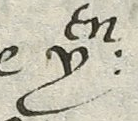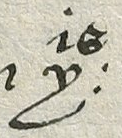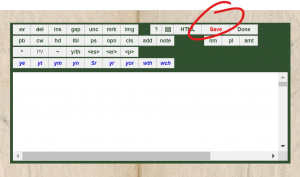Dromio: Folger Transcription Platform: Difference between revisions
BethDeBold (talk | contribs) (→FAQ) |
BethDeBold (talk | contribs) (→FAQ) |
||
| Line 444: | Line 444: | ||
*'''Do I need to save my work, or will it save automatically?''' | *'''Do I need to save my work, or will it save automatically?''' | ||
:Yes, you need to save your work in Dromio, and you should do so often. To save your transcription, click on the [Save] button that is located near the right end of the top row of buttons in the transcription editor window. | :Yes, you need to save your work in Dromio, and you should do so often. To save your transcription, click on the [Save] button that is located near the right end of the top row of buttons in the transcription editor window. | ||
[[File:Savedromio.jpg|thumb|left]] | :[[File:Savedromio.jpg|thumb|left]] | ||
<div style="clear:both"></div> | <div style="clear:both"></div> | ||
*How do I move or resize the transcription editor window? | *How do I move or resize the transcription editor window? | ||
Revision as of 11:58, 29 April 2020
Dromio, named for the comedic twins in "Comedy of Errors," is a transcription interface designed by the Folger Shakespeare Library to allow the transcription and comparison of transcriptions of early modern manuscripts. It was first developed through the Early Modern Manuscripts Online (EMMO) project. This page includes information on how to transcribe and encode using Dromio. This page can be downloaded as a pdf here.
Getting Started
1. Launch your Internet browser (preferably Mozilla Firefox or Google Chrome). Make sure your browser is up-to-date. Turn off auto-correct and spell-check in your browser settings.
2. Type the following URL in the browser window (or click on this link): http://transcribe.folger.edu/. Type your first and last name in the dialog box where it says “Enter your full name” and press the Submit button.
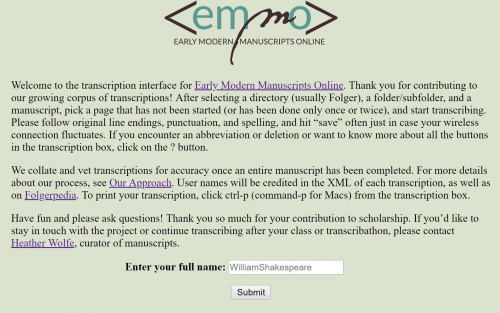
3. Select a transcription project or workshop/event from the list (Note: this list often changes).
4. Dromio will display a list of subfolders or documents available for transcription (this list is subject to change and is not exhaustive; let us know if you would like a Folger manuscript added or placed in a separate folder for teaching):
5. After selecting a subfolder, Dromio will display a list of documents or openings available for transcription within the subfolder. In the left column, you will see the Folger call number and title. In the middle column are page numbers for each digital image of a manuscript page or opening. The right column records the transcription status of each page, indicating how many individual transcriptions have been started and saved, and how many have been completed (marked Done by individual transcribers).
6. Click on the page or folio number that you wish to transcribe. The digital image of the page or page(s) will appear.
- The Zoom (+ and -), Rotate (⤾ and ⤿), Home (returns to original size) and Full Screen (image only view) tools are in the upper left corner. Each click of the Rotate arrows rotates the image 90 degrees.
- The transcription window can be moved around by dragging the dark green top of the window with your cursor.
- You can enlarge the transcription window by clicking and dragging the bottom or sides of the window with the cursor.
- To start transcribing, type directly into the transcription window. Remember to click Save frequently to save your work. It will turn from red to black when you save.
How to Use XML Tags
This section discusses how to use the XML tags in Dromio to encode your transcription.
XML (extensible markup language) is a tagging language used to describe text in a digital environment. The XML tags allow transcribers to record information on how text appears upon the manuscript page (i.e. the head tag <head> indicates a heading or title). Tags may also convey information about words in the text (i.e. the <name> tag denotes a proper name). The XML tag set for EMMO is based upon the TEI (Text Encoding Initiative) tag set which is used to encode printed and handwritten texts for a digital environment. With the exception of the line break tag (lb/), all XML tags come in pairs, with an opening and close tag surrounding text (i.e <place>London</place>.)
Dromio makes encoding easier through a menu of buttons for commonly-used tags at the top of the transcription window. These buttons are “shortcuts” which insert XML tags around words without your having to type these tags manually. The tag names on these buttons have been abbreviated to save space (for instance, the <name> tag appears as “nm”).
Step-by-Step: Encode in Dromio
- Select the letter(s) or word with your cursor that you wish to encode.
- Click on an encoding button (referred to as a "tag button" throughout this document) from the menu to apply the XML tag to the selected text.
- The style of the text (its appearance) changes in the HTML window as you encode it by adding tags.
- If you want to remove the tag, re-select the encoded text and re-click the tag.
- You can switch between HTML and XML views by toggling the <xml>/<html> button.
- Tags act like bookends, enclosing the text that they affect. If one of these "bookends" is missing, the tag won't function properly. An open tag (<example>) must always be "closed" at the other end by a closing tag, which is the same text as the opening tag but preceded by a forward slash (</example>). If you are “stuck” in a tag, sometimes it is useful to go to the XML view and move the closing tag manually to where it belongs.
- Common early modern brevigraphs (ways of abbreviating text) have their own buttons (ye=the, yt=that, yr=your, ym=them, wth=with, and wch=which). Simply click on the button to insert the pre-filled abbreviated word, including XML tags, into the transcription. You do not need to type the word first.
- You can apply more than one XML tag to a section of text. This is called “nesting.”
- Click the Save button frequently to save your work. Select Done when you have completed transcribing and encoding the page. Don’t worry if you accidently hit Done or want to make a correction after you hit Done. You can still make changes and resave.
To learn more about XML and take a tutorial if you wish, try www.w3schools.com.
Glossary of XML buttons
Arranged by function, with examples in parentheses.
Remember, when selecting most tag buttons in Dromio:
- first transcribe the expanded form of the word
- select the letter(s) to be tagged with your cursor
- then click on the tag button to apply it
Text of the Manuscript as viewed
- ex = for expanded (i.e., supplied) text:
- command
- spl = supplied text to correct scribe’s mistake; use sparingly:
- “hitt" for erroneous writing of “itt” as “htt” or “muche” when transcriber supplies missing letters from contextual clues
del= for cancelled (i.e., crossed out) text:
- this is an example of a
deletedword.
- ins = for intralineal insertion text
- this is an example of intralineal text
- gap = for a gap in transcription, illegible letters replaced by periods
- this is an example of a ... gap.
- unc = for uncertain text (transcriber enters best guess)
- this is an example of a word with an unclear letter.
- mrk = for notational mark (e.g. manicule, etc.), include one-word description of mark.
- this is an example of a manicule in a sentence.
- Also used for periods/colons used in abbreviations.
- img = for image/illustration (e.g. drawing), include one-word description of image
- This is an example of a drawing.
- ? = help screen
- <xml> = shows text with xml tags
- Save = saves changes
- Done = indicates transcription/encoding completed
Layout/Non-textual Elements
- pb = for two or more pages in one image (page break) ( ) tag only [doesn’t show except in XML view] to indicate beginning of second opening, or (35) surrounding contemporary foliation or pagination or (4r) for foliation or pagination added by librarian or other steward.
- cw = catchword (word repeated on bottom of page/top of next page)
- When
- hd = for obvious headings
- Cooking with Clarified Butter
- lbl = for labels or in the margins or other forms of marginalia
- For a toothe-ache
- qt = quote (for discernible hand-shift indicating quotation)
- ps = for postscript text in letters
- Do not forgetteth to write
- opn = for text of opening in letters
- To my most lovinge husband
- cls = for text of closing in letters
- Your most dejected servant,
- add = for added text by booksellers, librarians, collectors, etc. (only for additions made clearly later)
- V.a.110
- note = for note at the end of the text file
- Try not to use this field unless you are leaving note for vetter—we don’t currently have a way to make this information visible in a useful way.
Content
- nm = for proper names (non-fictional)
- William Shakespeare
- pl = for identified places
- Stratford-on-Avon
- amt = for specific monetary amounts (include numeral and currency symbol)
- iiis vd
Semi-Diplomatic Transcription
You will be making a “semi-diplomatic” transcription, meaning you will maintain original spellings (even if they are incorrect by modern standards) and will record any deletions or additions.
- ^ = for superscript text not to be lowered.
- Use this for superscript currencies and ordinal numbers [iiiith] but nothing else
- \^/ = for superscript text to be lowered
- Saint; October
- ~ = macron (¯) or tilde (~), for tilded letters such as “n” or “conm̄”
- running for ruñing
- y/th = for thorn letter (looks like “y”), transcribed as “th”
- ye = the
- <es> = for “es” graph
- chyldes
- <er> = for “er” graph (transcribed as “er,” or ar/or/re)
- peter
= for special “p” graph (following two letters should be expanded text, “pre,” “pro,” “par,” or “per”)
- partie
- ye=transcribed as “the”
- the
- yt=transcribed as “that”
- that
- ym=transcribed as “them”
- them
- yr=transcribed as “your”
- your
- wth=transcribed as “with”
- with
- wch=transcribed as “which”
- which
Examples
Frequently seen writing conventions in secretary hand (as well as other marks commonly appearing on early modern manuscripts), how they are transcribed, and how they are rendered in XML using tag buttons in Dromio. The Dromio transcription window automatically shows the transcription tags in HTML, so to see the actual XML code, you may toggle the xml button.
Note that the name of the tag button in the dromio transcription window is not always the same text of the tag in XML (for example, the tag button for tagging a drawing is "img," but the actual XML tag used is <graphic></graphic>).
Expansion
Transcription: Portsmouth
In XML: Portsm<sl>o</sl><ex>uth</ex>
Tag button used: ex
- Expanded, i.e. supplied, text. Note: in this example, the superscript "o" is also silently lowered with the \^/ tag button. The "expansion" tag makes the tagged selection appear italicized.
Deletion and Insertion
Transcription: not^hard
In XML: <del>not</del>^<ins>hard</ins>
Tag buttons used: del (delete) and ins (insert)
- Intralineal inscription and deletion; add caret only if present in ms. "Delete" tag draws a line through the tagged selection, and the "insert" tag superscripts the tagged selection.
Gap
Transcription: Invidi repair to hole in paper lebrane queam
In XML: Invidi <gap>repair to hole in paper</gap> lebrane queam
Tag button used: gap
- For a gap in transcription, estimated number of illegible letters replaced by periods. Highlights selection in red.
Unclear
Transcription: or draw what you please, then with
In XML: or draw what you please, th<unclear>en</unclear>w<ex>i</ex><sl>th</sl>
Tag button used: unc
- For uncertain text (transcriber enters best guess within tag). Highlights tagged selection in yellow. Note: in this example, "with" has the "i" expanded using the ex tag button, and the "th" silently lowered using the \^/ tag button.
Mark
Transcription: Aristoteles manicule
In XML: <label>Aristotles</label><metamark>manicule</metamark>
Tag button used: mrk
- For notational mark (e.g. manicule, etc.), include one-word description of mark, i.e. in place of the symbol, write and tag the word "manuicule." Also used for brevigraph markers such as a period (.) or colon (:) when they disappear as part of the word’s expansion. This button highlights tagged selection in gray. Note that in this example the word "Aristotles" is tagged as a label using the lbl tag button.
Drawing
Transcription:
nascono molte herbe onde paieno
giardini.
Drawing showing a house in Cyprus
Forma delle case di Cipro
Modo di tibiar
In XML:
<lb/>nascono molte herbe onde paieno
<lb/>giardini.
<lb/><graphic>Drawing showing a house in Cyprus</graphic>
<lb/><label>Forma delle case di Cipro</label>
<lb/><label>Modo di tibiar</label>
Tag button used: img
- For image/illustration (e.g. drawing), include short description of image and tag the description. Highlights tagged text in light/bright blue. Note that in this example, you can see the "line break" tag (<lb/>) that is automatically inserted at the beginning of each line every time you hit the "return" key for a new line. Note also that the transcriber has tagged the text appearing next to the image using the label tag button, lbl.
Catchword
Transcription:
The spiritte which your sack hath lent./
An Epitaph
In XML:
<lb/>The spiritte which your sack hath lent./
<lb/><catchword>An Epitaph</catchword>
Tag button used: cw
- Used for a word appearing at bottom that also appears on the top of the next page. Turns tagged text gold.
Page break
Transcription:
The spiritte which your sack hath lent./
An Epitaph
61
An Epitaphe
In XML:
<lb/>The spiritte which y<ex>ou</ex><sl>r</sl> sack hath lent./
<lb/><catchword>An Epitaph</catchword>
<lb/><pb>61 </pb>
<lb/><heading>An Epitaphe </heading>
Tag button used: pb
- For two or more pages in one image. Note that the tag encloses the number of the new page. Highlights text in dark gray.
- Note that in this example you also see the "line break" tag automatically inserted whenever you hit the return key for a new line. You also see the first "An Epitaph" tagged with the cw tag button, and the second "An Epitaphe" tagged with the hd tag button. Finally, you also see an example of the word "your," with "ou" expanded using the ex tag button and the "r" silently lowered using the \^/ tag button.
Heading
Transcription: Panegyricks
In XML: <heading>Panegyricks</heading>
Tag button used: hd
- “Heading” tag used for page or section heading. Underlines the tagged text.
Label
Transcription:
A viewe of the pre=
sent estate of
Ireland discour=
sed by way of a
dialogue between
Eudoxus and
Irenis.)
In XML:
<lb/><label>A viewe of <brev-y>th</brev-y><sl>e</sl> pre=
<lb/>sent estate of <place>Ireland</place> discour=
<lb/>sed by way of a
<lb/>dialogue between
<lb/><name>Eudoxus</name> and
<lb/><name>Irenis</name>.)</label>
Tag button used: lbl
- Used for a “label” or note in the margin of the page. Tag button puts tagged selection in bold.
- Note that in this example, other tags used include: a y-brevigraph changed to "th" with the "e" silently lowered using the ye shortcut button; a place name tagged using the pl tag button, and two names tagged using the nm tag button.
Postscript
Transcription:
Postscript:
I haue sent you here inclosed a note
how all our mony is layed forth and
I pray you send vs vp some more as soone
as you can for I haue neede of soute
a new sute of Apparill.
In XML:
<lb/><ps>Postscript:
<lb/>I haue sent you here inclosed a note
<lb/>how all our mony is layed forth and
<lb/>I pray you send vs vp some more as soone
<lb/>as you can for I haue neede of <del>soute</del>
<lb/>a new sute of Apparill.</ps>
Tag button used: ps
- Used to indicate a postscript found at the end of a letter. Tag button turns tagged selection light gray or white.
- Note: other tags used in this example include the use of the
deltag button to indicate that the word "soute" in the second to last line has been deleted. The "line break" (<lb/>) tag appears at the beginning of each new line, and is automatically inserted when a transcriber hits the "return" button.
Opening
Transcription: Deare father,
In XML: <opn>Deare father</opn>,
Tag button used: opn
- Stands for opening of a letter. Both greeting and name are included in tag. Tag button turns tagged selection white with a gray background.
Closing
Transcription:
Your diligent and most
obedient sonne
Walter Bagott
In XML:
<lb/><cls>Y<ex>ou</ex><sl>r</sl> diligent and most
<lb/>obedient sonne
<lb/><name>Walter Bagott</name></cls>
Tag button used: cls
- Close tag, indicating close of a letter. Tagged selection should include both the salutation and name, though the name should also be tagged using the nm tag button, as it is in this example. The cls tag button will highlight the tagged selection gray and turn any text white.
- Note: other tags used in this example include the use of the ex tag button to expand the "ou" in the word "Your." The letter "r" in "Your" is also silently lowered using the \^/ tag button.
Added text
Transcription: L.a.176
In XML: <add>L.a.176</add>
Tag used: add
- This tag is used to indicate text added to a manuscript by a later hand (such as a page or call number added by cataloguer). Tag button will turn any characters in the tagged selection red.
Note
Appearance in dromio: This manuscript was transcribed by William Shakespeare.
In XML: <note>This manuscript was transcribed by William Shakespeare.</note>
Tag button used: note
- Textual note added by transcriber, usually at end of document. As mentioned above, please use this tag sparingly, as we currently have no way of making information entered using the notes tag visible in a useful way (April 2020).
Personal Name
Transcription: William Bagott
In XML: <name>William Bagott</name>
Tag button used: nm
- Proper names of individuals. Tag button turns background of tagged selection blue with white characters.
Place Name
Transcription: of France,
In XML: of <place>France</place>,
Tag button used: pl
- Used for place names. Tag button turns background of tagged selection blue with white characters.
Monetary Amounts
Transcription: xij.s xd [12 shillings, 10 pence]
In XML: <amt>xij.<sup>s</sup> x<sup>d</sup></amt>
Tag button used: amt
- Used for a monetary amount/measurement. Tag button turns background of tagged selection dark green.
- Note: abbreviations for coinage, such as “s” (for shilling) and “d” (an abbreviation of the roman word "denarius," used to indicate "pence" in Britain until 1971) should be indicated using the superscript tag button: ^. The <amt></amt> tags should enclose both the number and monetary symbol with its superscript tags, so that they are "nested" inside the "amt" tags.
Superscript
Transcription: death which was 7o No:vember 1622.
In XML: death <span>w<ex>hi</ex><sl>ch</sl></span>was 7<sup>o</sup> No<metamark>:</metamark><ex>vember</ex> 1622.
Tag button used: ^
- Used only for letters or characters written in superscript such as l, s, d, for money, and Latin ordinal number symbol “o.”
- Note other tags used in this example: a shortcut to expand wch into "which," where the "hi" are tagged using the ex tag button and the "ch" is silently lowered using the \^/ button; and the use of the mrk tag button to indicate the colon that disappears when "November" is expanded, as well as the use of the ex tag button once again to add "vember."
Superscript Lowered
Transcription: then:
In XML: <brev-y>th</brev-y><sl>en</sl><metamark>:</metamark>
Tag button used: \^/
- Used for text written in superscript that is “silently lowered” during transcription. The tag button turns the color of the text tagged in the selection dark brown. In this example, this common spelling of the word "then," yen, has been changed to expand "y" (thorn) to "th" using a brevigraph shortcut tag button, y/th, and to silently lower the "en" using the superscript-lowering tag button.
- Note that the metamark tag button mrk has been used on the colon at end of expanded word in this example.
Macron expansion
Transcription: Commendaciones
In XML: C<macron>om<ex>m</ex>e<ex>n</ex>d</macron>aciones
Tag button used: ~
- Used to indicate a vertile line or tilde over a single character, usually an "m" or "n," which signifies doubling of that character. The tag button turns the text in the tagged selection green. In this example, the macron has been expanded to show both "m"s using the ex tag button on the second m, and the "macron" tag button is put around both characters. The "macron" tag should enclose all characters over which the line extends in the original manuscript, which in this example includes the middle four written characters.
- Note: in this example, the "n" has also been expanded using the ex tag button.
Thorn
Transcription: this:
In XML: <brev-y>th</brev-y><sl>is</sl><metamark>:</metamark>
Tag button used: y/th
- The character "y," known as a "thorn," is transcribed as “th." The y/th tag makes this exchange/expansion. The tag button turns the text in the tagged selection green and italicizes it. In this example, “is” as a superscript is lowered using the superscript-lowering tag button \^/.
- Note: if present, a colon or period is placed in the metamark tag using the mrk tag button.
-es graph
Transcription: recusantes
In XML: recusant<brev-es>es</brev-es>
Tag button used: <es>
- Used to expand the "-es" abbreviation at the ends of words. The tag button is a shortcut that applies italicization and turns the tagged selection green.
- Note: the "-es" graph is a downward stroke at the ends of words, as opposed to the upward stroke commonly used for a "sigma" s. For more information and examples, please see the Alphabet Book.
-er graph
Transcription: neuerthelesse
In XML: neu<brev-er>er</brev-er>thelesse
Tag button used: <er>
- Used to expand and silently lower the "er" abbreviations. The tag button is a shortcut that adds italicization and turns tagged selection green. Remember that "-er" graphs can also potentially be transcribed as -ar, -or, or -re, depending on context.
Special P
Transcription: provyded
In XML: <brev-p>pro</brev-p>vyded
Tag button used:
- Used to indicate expanded "special p." Note that the transcriber will need to provide the expansion themselves, as with the -er and -es graphs, before applying the tag. Tag button turns tagged selection green. "Special p" can be expanded pro, per, par, or pre depending on context, but note that the ex tag button is NOT used.
Shortcuts
Clicking on one of the last six brevigraph buttons in the Dromio menu will insert the entire word and its XML tags--you do not need to type the word before clicking the button. If there is a period or semi-colon as a brevigraph marker, move it to the end of the word and tag it as a metamark. This allows our stylesheet to render the word both diplomatically and semi-diplomatically.
- yt
- "y" is the letter "thorn," equivalent to "th." This shortcut tag button will insert that
- ye
- Another shortcut for words using a thorn. This shortcut tag button will insert the
- yn
- Another shortcut for words using a thorn. This shortcut tag button will insert then
- ym
- Another shortcut for words using a thorn. This shortcut tag button will insert them
- Sr
- A shortcut tag button for the word "Sir." This shortcut tag button will insert Sir
- yr
- A shortcut tag button for an abbreviation for "your." This shortcut tag button will insert your
- yor
- Another shortcut tag button for a variant abbreviation for "your," to be used when the "o" is already present. This shortcut tag button will insert your
- wth
- A shortcut tag button for an abbreviation for "with." This tag button will insert with
- wch
- A shortcut tag button for an abbreviation for "which." This tag button will insert which
FAQ
- Is there any general information about the tags and how to transcribe in Dromio?
- Yes. If you open any image to transcribe in Dromio, you will see a [?] button on the transcription editor window. Click on that button, and a Help page will open with a glossary that describes each button and its corresponding tag. The Help page also gives examples of each tag and general information about how to encode your transcription in Dromio.
- Do I need to save my work, or will it save automatically?
- Yes, you need to save your work in Dromio, and you should do so often. To save your transcription, click on the [Save] button that is located near the right end of the top row of buttons in the transcription editor window.
- How do I move or resize the transcription editor window?
- What is a semi-diplomatic transcription?
- What are silently-lowe red letters and how should I e nter these?
- Should I modernize the spelling of words as I transcribe?
- Do I have to enter line breaks?
- What are expansions and how do I enter the m?
- What do the shortcut buttons do?
- When should I use theinsertion, silently-lowe red, and superscript tags?
- What are brevigraphs and how do I enter the m?
- What should I do with symbols, drawings, or other non-textual elements?
- What are nested tags and will I need to use them when transcribing?
- What do I if I get an error message about overlapping hierarchies?
- What is a deletion and how should I tag this?
- Should I tag page numbers and shelf marks?
- What should I do if I can’t make out a wordor letter?
- How do I indicatea page breakfor a two-page spread image?
- What is a heading?
- How should I use the amount tag?
- Should titles be included in personal names?
- Should I include the text of a signed name in the closing tag?
- What should I do about marginalia (and what is marginalia)?
- How should I use the macron tag?
- Can I enter notes about the transcription, and if so, how should I do this and where?
- How should I enter text written vertically on a manuscript page?
- How do I record s ums/arithmetic calculations?
- When should I hit the Done button?
- Can I make changes after I’ve hit the Done button?
- What should Ido when Icome across a blank page?
- Can I enterspecial characters like ash or ethel(æ or œ),and if so, how?
- Should I tag shifts of hand, changing sizes of text, spacing, or different-colored ink?
